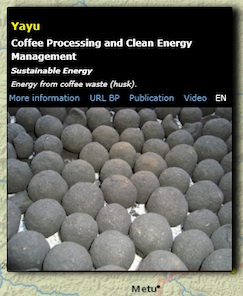Energy from coffee waste (husk).
 Annual Coffee production in Ethiopia is about 240,000 green coffee. This generates equal amount of waste (husk). In Yayu alone, over 20,000 tonnes of coffee waste is produced annually, and all not used.
Annual Coffee production in Ethiopia is about 240,000 green coffee. This generates equal amount of waste (husk). In Yayu alone, over 20,000 tonnes of coffee waste is produced annually, and all not used.
Alternative uses for coffee husks include employing this solid residue as a supplement for animal feed, direct use as fuel, fermentation for the production of a diversity of products (enzymes, citric acid and favoring substances), use as a substrate for growth of mushrooms and use as adsorbents.
Briquettes – charcoal from husk
In Yayu area alone, over 5,100 tonnes of briquettes can be produced. Heating value of agglomerated briquette is about 5318.45 cal/g, while that of beehive briquette is 4033.3 cal/g. This is comparable to charcoal from wood like prosopis, chats,… And hence has a great potential for local energy and generating cash income- supply to cement industry.
The husk can also be exploited for the production of ethanol, biogas or biodiesel.
Related links:
Environment and Coffee Forest Forum (ECFF) | Yayu Coffee Forest Biosphere Reserve















